Blogger outreach is a strategy that uses email to promote your content and establish connections with influential creators. While it's a cost-effective marketing approach, it’s also challenging to execute effectively and carries a significant risk: of getting the spammer badge.
In the article, we show you how to identify and vet blogger outreach opportunities and how to write emails that drive results.
What is Blogger Outreach?
Blogger outreach is a marketing strategy used to put your product, service, or content in front of relevant bloggers and influencers. By sending them personalized emails.
The goal?
To convince bloggers in your niche with large audiences to mention your brand or content and provide links to your website.
What Can You Use Blogger Outreach For?
You can use blogger outreach to boost your online presence and marketing efforts in a variety of ways. Here are a few common ones.
Guest or sponsored post
SEOs and writers use blogger outreach to secure opportunities to write guest posts or sponsored content on relevant blogs. This gives them increased exposure and backlinks.
What does outreach for guest posts look like?
Here’s an example of a guest post outreach template used by Colm O'Regan, a content marketing writer, consultant, and founder of ScienceCopywriting.com:
Hello,
Colm here from ScienceCopywriting.com
I found your "write for us" page, and you mention you accept guest contributions. Is this still the case? If so, I’d love to write an article for you.
Looking at your site, you have several How-to guides. So, I think one of the following would be ideal:
1. Blog post headline X
2. Blog post headline Y
3. Blog post headline Z
Which of those ideas do you like most?
I can come up with a few more if you'd prefer. Just let me know.
Thanks,
Colm
Backlink exchange
Companies use blogger outreach to negotiate backlink exchanges. That’s when bloggers and website owners agree to link to your site and you reciprocate by linking back to their website.
Backlink exchanges are a bit of a grey area: they can be classed as a scheme to manipulate search rankings. That’s a gross violation of search engine guidelines.
That’s why many companies use ABC link exchanges instead. You link to their site, and they link back to one of your other partner’s sites. They pay you back with a link from theirs.
That’s the strategy used by Kimberley McConnery, the Link Building Manager at Sure Oak. Here’s a template that Kimberley uses to reach out to potential partners.
Hello there!
X here, an outreach expert from X, an SEO company with a link exchange offer.
I’m working on a campaign for our domain, and it would be fantastic if we could explore an A-B-C link exchange that benefits us both.
In case you don't have any other websites, I have a ton of different partner websites where I could earn a link for your website, and that way, we would avoid a direct link exchange, keeping our websites safe 🙂
So, are you up for an exchange?
Warm regards,
X
Broken link building
Broken link building involves identifying broken links on other websites and reaching out to suggest replacing them with active, relevant links to your content.
What does it look like in practice?
I asked Sergey Galanin, the SEO Director at Phonexa, and here’s a template that he’s shared:
Hi There (Blogger's name)
I came across a very insightful article on X while researching X. I particularly enjoyed how you articulated your thoughts in section X.
However, I noticed that a link to X seems broken and leads to a 404 error page.
I have actually recently published a piece on my website {Phonexa.com) titled X that deeply covers X. It could be a valuable resource for your readers. Here is a link to my article:
Let me know if it’s a good fit. I'd be happy to see it linked in your existing article.
Best Regards,
Sergey
Product reviews
Marketing teams use outreach to establish relationships with bloggers who could review their products. This increases product visibility and leverages the blogger’s authority to build customer trust.
Have a look at what it looks like:
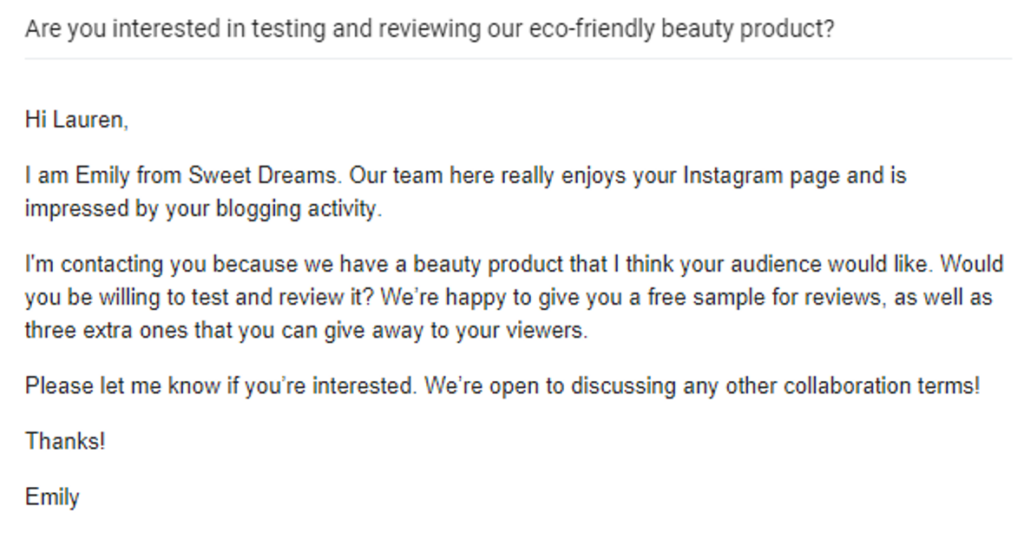
Partnerships
Blogger outreach can pave the way to partnerships with influential bloggers and content creators.
Such partnerships could involve collaborative projects, cross-promotions, or other joint marketing campaigns that benefit all involved parties.
Here’s a template example you could use to reach out to bloggers you’d like to collaborate with:
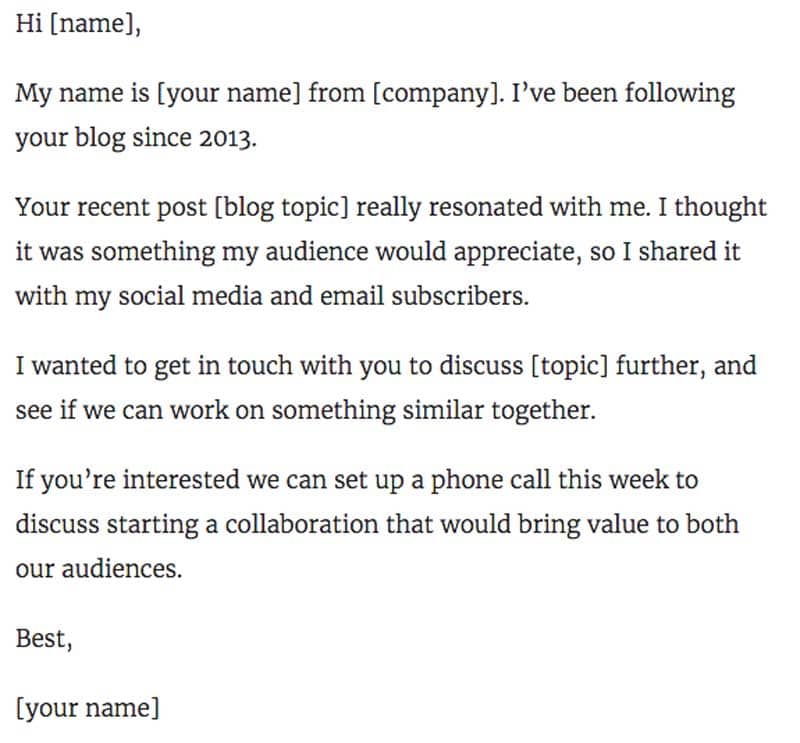
Benefits of Blogger Outreach
Blogger outreach is a popular tactic because it offers multiple benefits.
These include:
- Improving SEO: Blogger outreach can significantly improve your website's SERP performance thanks to backlinks from high-authority blogs.
- Driving traffic: Links and mentions from popular blogs direct their readers to your website, increasing traffic.
- Increasing sales and conversions: Exposure through influential blogs can lead directly to increased sales and conversions. According to Traackr’s 2024 UK Impact report, 63% of consumers are more likely to buy a product recommended by a trusted influencer. And 82% of brands find influencer marketing better for generating high-quality leads.
- Enhancing brand visibility and awareness: By getting your content featured on well-established blogs, you can increase your brand’s visibility and awareness. And reach a broader audience that may not have been accessible otherwise.
- Content promotion: Blogger outreach provides an avenue to promote your content directly to interested audiences. This boosts your content marketing efforts and ensures your content reaches its target audience.
- Establishing thought leadership: Being featured on reputable blogs helps establish your brand as a thought leader in your industry. This enhances your brand’s credibility and authority.
- Building relationships: Blogger outreach helps in building long-term relationships with influencers and bloggers within your niche. These relationships can be beneficial for mutual promotions and gaining credibility through association.
How To Do Blogger Outreach?
Before we get into specific tactics and best practices, here’s an overview of the process.
- Start by defining your goals: Are you building a blogger outreach strategy only to build links? Or to increase your online presence and brand awareness as well? Your goals determine the choice of tactics. For example, if link-building is your main focus, link exchanges and broken link-building require the least effort, so that’s what you should prioritize.
- Use Google, social media search, and SEO tools to research relevant bloggers and influencers in your niche. Vet them to ensure their websites have the right metrics, and align with your brand’s values and audience.
- Having compiled the list of prospects, create personalized outreach emails that highlight mutual benefits and clearly spell out why collaborating could be advantageous for them. Include specific details about how their audience could benefit from your content or product.
- After sending your emails, follow up respectfully to enhance response rates.
How to Find Blogger Outreach Opportunities?
The success of your blogger outreach campaigns depends on identifying relevant bloggers in your niche. Here are 3 strategies I’ve found to work particularly well.
Use Google Search
Google Search is a free and effective tool for blogger research.
First, make a list of keywords related to your niche. If you’re in the SEO space, these could be:
- SEO optimization
- SEO marketing strategies
- Local SEO
- SEO keywords research
- SEO content creation
- On-page SEO
- Technical SEO
Next, run a search on each of them. Scan the SERP for relevant blogs and assess their suitability.
If you’re looking for guest post opportunities, Google advanced search operators come in handy:
- KEYWORD "write for us".
- KEYWORD "guest post".
- KEYWORD "guest article".
- KEYWORD "become a contributor".
- KEYWORD "guest post guidelines".
- KEYWORD Inurl:"write-for-us".
- KEYWORD Inurl:"guest-post"
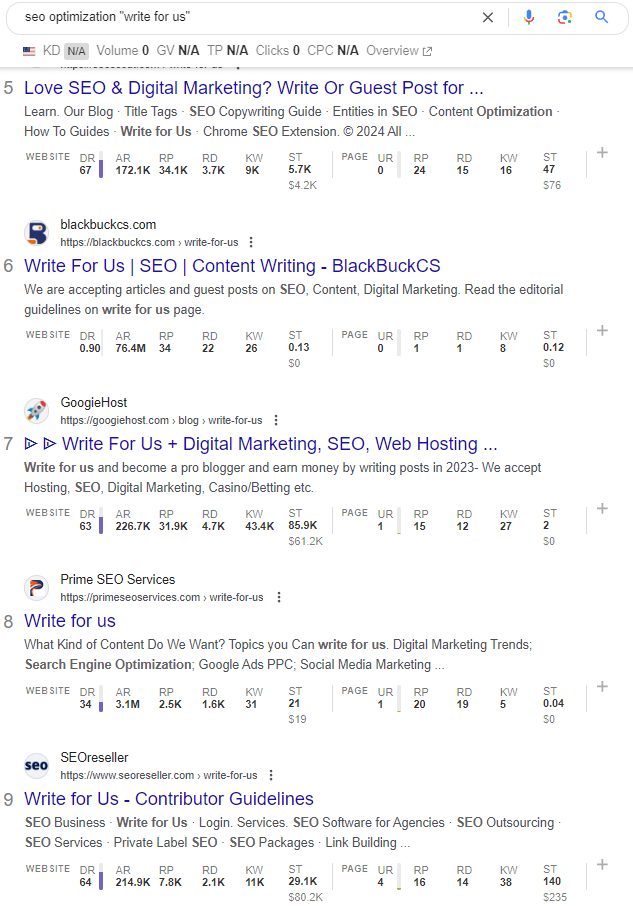
Google allows you also to set alerts. In this way, you get notified whenever new content on your topic or an unlinked mention appears.
Use an SEO tool
SEO platforms, like Ahrefs or Semrush, offer tools that can streamline the search process.
Here’s how I use Ahrefs for this.
1) In Content Explorer, change the search type to ‘In title’ and run a search for your keyword.

2) Filter the links by ‘One page per domain’ and add your URL to the Highlight Unlinked feature.
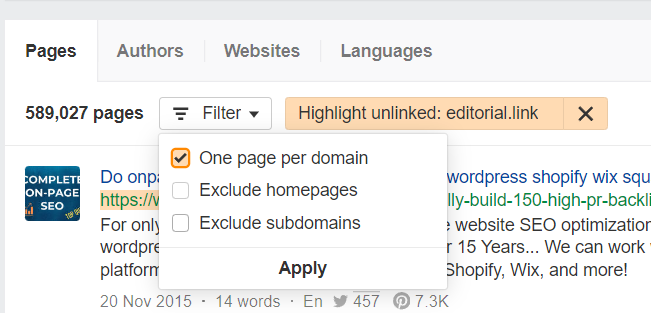
3) Filter the results by domain. Colm O’Regan recommends targeting sites with DR 25-60 for the right balance between difficulty and quality.

4) Export the results
You can identify further opportunities by analyzing the referring domains linking back to articles on your topic.
1) In Content Explorer, search for pages with relevant content, like above.
2) Filter the results by referring domain count (>10).
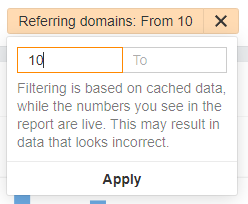
3) Order the results by referring domains, high to low.
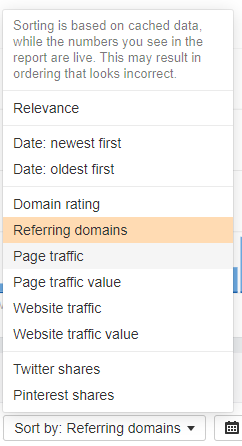
4) Copy the URLs of relevant articles into Site Explorer.

5) In the Backlinks report, filter the results as above.

To find unlinked in brand mentions, use Content Explorer.
1) Search for your brand (In content)

2) Add your domain URL in ‘Highlight unlinked’.
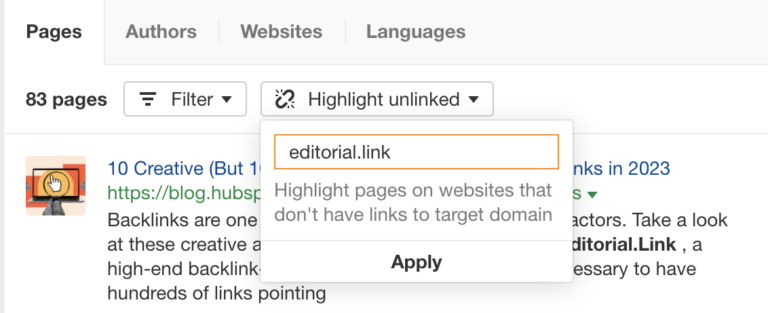
3) Filter the data by language, DR, traffic, etc.
4) Export the pages with highlighted domains into a spreadsheet.
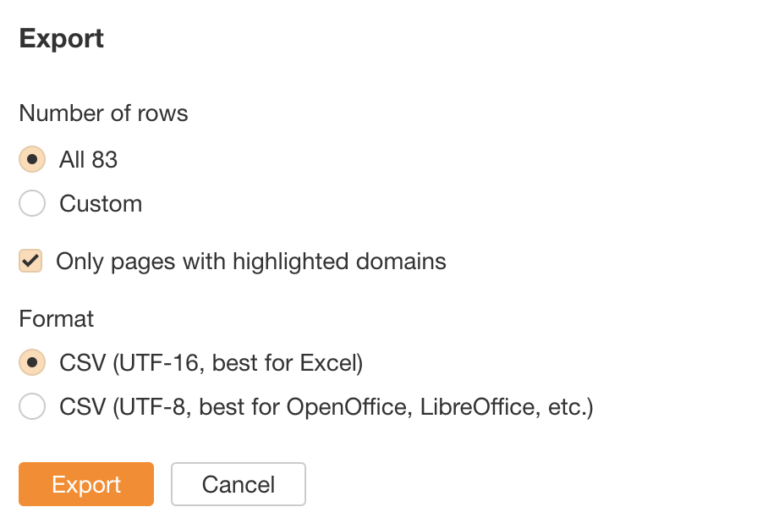
Use outreach tools
Dedicated outreach tools, like BuzzSumo, Roxhill, or Pitchfork have tools that all you to find relevant bloggers or influencers in no time.
Here’s how to do it in BuzzSumo.
1) From the Influencers tab, choose X Influencers.

2) In the search bar, enter your keyword and change the search settings to ‘Tweeted articles from the website.’
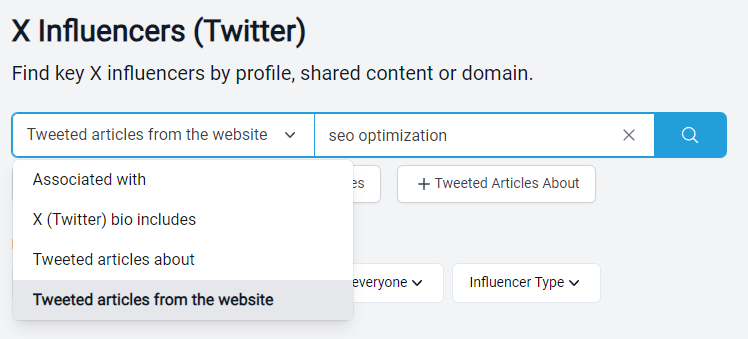
3) In the Influencer Type dropdown, choose toggle Blogger on.
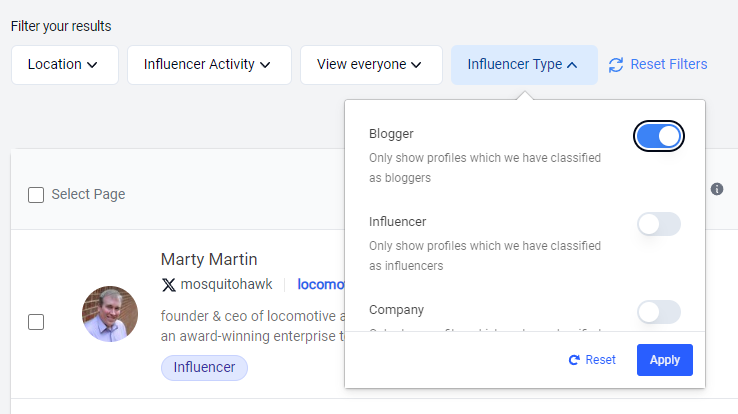
4) In the Influencer Activity, toggle Active Influencers on.
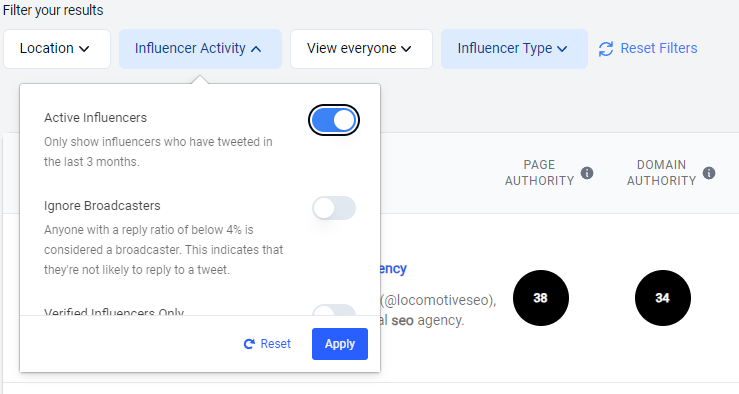
5) Export the results and filter them by DA and follower count.
How to Vet Your Outreach Prospects
Once you have a list of potential bloggers to target in your outreach campaign, vet them. To ensure the best success rate and allocate your resources effectively.
While compiling your list, you already make initial vetting, for example, based on their DR or website traffic. That’s just a start though.
What do you do next?
I’ve asked James Taylor, SEO Strategist at Embryo.
His team at Embryo uses a custom 'greenlist' approach. It’s based on a sheet where they manually assign a score to each blogger prior to outreach.
Here’s are the checkpoints in the list:
- Has traffic declined since the HCU (Helpful Content Update)?
- Is the blogger consistently active on one or more form of social media?
- Do they link out to niches such as gambling or anything that could be considered a 'grey' area?
- Do they have categories far outside of their niche (for the sole purpose of selling backlinks)?
- Of the recent posts that they're published, are these getting indexed?
- Is the content they're publishing written by AI?
- When we reach out, do we get a templated response referencing a guest posting fee?
- Are their current keywords contextual to their website e.g. are they receiving traffic from articles that 'make sense'?
The team scores each blogger on these criteria manually. The lower the score, the closer to green the grade becomes. Then, they filter by '0' scores and pick prospects from the blogger outreach 'greenlist'!
Blogger Outreach Best Practices
According to Backlinko research, only 8.5% of outreach emails receive a response. Let’s have a look at a few best practices to help you create emails that do get responses.
Craft an effective subject line
According to SuperOffice data, 33% of email recipients decided to open it based on the subject line, while Zippia has found that 69% use subject lines to report emails as spam.
What makes a good subject line?
- Personalization: Emails with personalized subject lines have 50% higher open rates and over 30% higher response rates.
- A number: Emails get 113% higher open rates if there’s a number in the subject
- A question: Embedding a question in the subject line can increase the open rate by to 21%.
- Right length: Best performing subject lines have 30-50 characters or 4-7 words.
Personalize your email
Backlinko data shows that personalized emails have a 32.7% better response rate than generic ones.

How do you personalize an email?
Personalization is more that using their first name. Make a relevant reference to their work, for example, by mentioning their articles or interviews. If possible, give a natural-sounding compliment.
This will make it more engaging, and consequently, increase your chances of success.
Here’s a good example of how to make a personalized guest post pitch from Ben Goodey’s blog, How the FxCK.
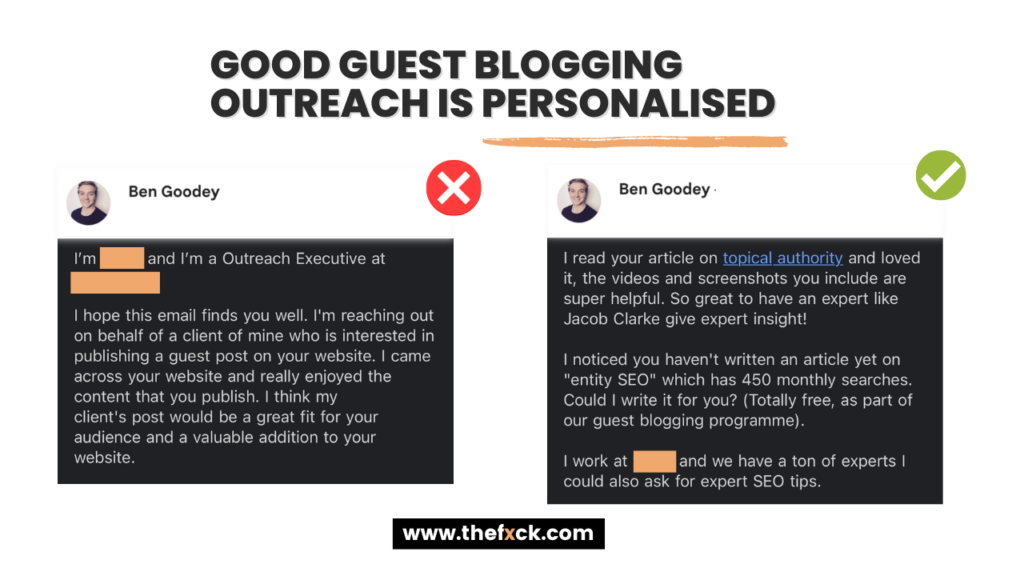
Offer value
For your outreach to be successful, always offer something of value in return.
Bloggers get tons of emails asking for links and mentions. If they added every helpful link, they wouldn’t have time to create content. Getting their own value from the collaboration will attract their attention and make them accept your offer.
Here are a few ideas on how to incentivize bloggers to help you:
- Invite them to join your affiliate program.
- Promotion their content on your social media, newsletter, or blog.
- Offer a free subscription to your products or services.
Here’s a good example of how to do it from Irina Maltseva, the Head of Growth at Aura:
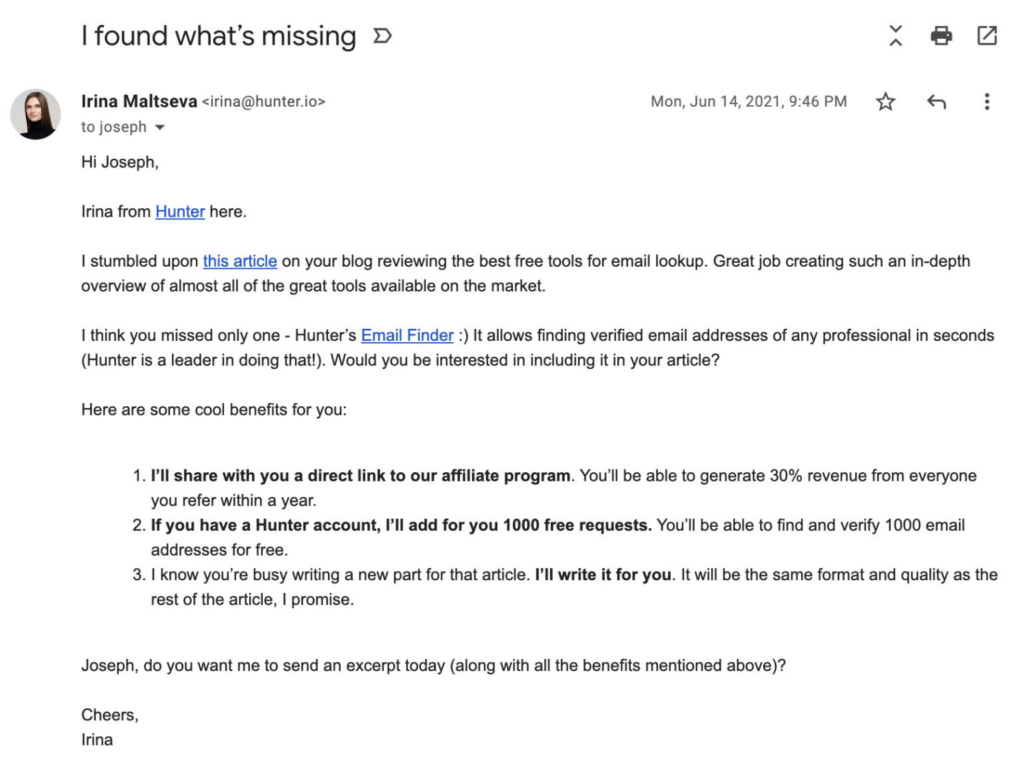
Make the email easy to read
According to the 2022 Trends in Email Engagement report by Litmus, people on average spend only 9 seconds looking at an email.
That’s all you have to get your message across, so make your email easy to digest.
Lindsay Davis has shared a few tips for creating easy-to-read emails:
- Put the most important information first (usually, it's what you want and what you offer in return).
- 1-2 sentences per paragraph.
- Keep your emails less than 100 words.
- Use clickable text instead of naked URLs.
- Add white spaces between paragraphs.
Get to the point
As mentioned, influential bloggers have plenty on their plates. Taylor Scher, an SEO Consultant, recognizes this and recommends cutting to the chase:
To me, it’s the best way to cut the BS and get straight to the point. I don’t have to say “I love your article, it’s so amazing omg,” I can say “Hey, you have this broken link on your website, here’s a quick alternative if you need it.” It’s so incredibly easy to do and it has the highest success rate of any of my other link-building channels.
Follow up
The most successful outreach campaigns target their audience with sequences of emails.
Likely, your prospect doesn’t respond to the first email. However, by following up just once, you can increase the response rate by over 65%. Hunter data shows that 3 follow-ups bring the best results and the returns from further follow-ups decline considerably as per Woodpecker research.
How often should you follow up?
Belkins research shows that the optimal time is 2-5 days. Avoid the urge to follow up the next day as this may decrease your reply rate by up to 11%.
Wrapping Up
Blogger outreach is the foundation of many link-building strategies. It also increases your reach and online visibility and helps build long-term relationships that can bring more business opportunities.
Identifying and vetting bloggers, building a strategy that reflects your link-building goals, and creating highly personalized email campaigns are time-consuming and require expertise. Not all in-house teams have it.
That’s why outsourcing the process to a link-building agency may be a better use of your resources. If that’s what you’re considering, the Editorial.Link team can help. Get in touch for a free consultation.



